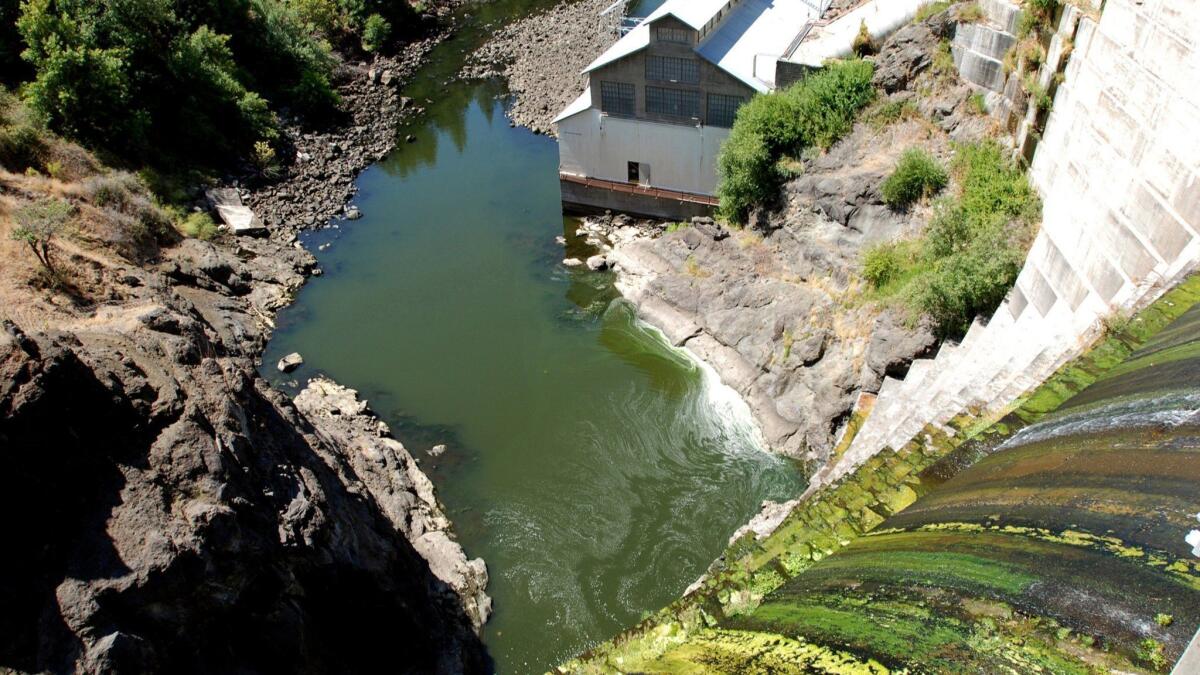Op-Ed: To save Klamath River salmon, shut down the hatcheries

In 2021, four large dams on the Klamath River are due to be demolished, in part to revive the river and Klamath Basin salmon. But unless salmon hatchery operations are discontinued soon afterward on the river, the effort will founder. Allowing hatchery salmon to mix with struggling native salmon after removing the dams is like rescuing a dying man only to slowly poison him.
The Klamath dam demolitions, the world’s largest dam removal project, offer a spectacular opportunity to return this California and Oregon river to its wild state. Native salmon will be able to swim an additional 400-plus river miles from ocean to historical spawning grounds, completing a life cycle that replenishes not just the stock of wild salmon, but the health of the basin. Klamath salmon are keystone species in a food web that includes at least 137 animals.
With sufficient habitat restoration and support for native fish, the Klamath could eventually reclaim its pre-dam ranking as the West Coast’s third-largest producer of wild salmon, after the Columbia and Sacramento rivers.
Salmon hatcheries don’t belong in this picture. They are relics of an outdated worldview that maintains that technology can conquer and control nature. They curtail salmon runs on the river, and instead of diverse stocks of fish that possess varied abilities enabling them to return to spawn — and die — at spots all along the river where they were born, hatchery fish’s birthplace is a single place: the hatchery. The identical life histories of these fish make them more susceptible to disease and predators than their native relatives.
The best hatchery is a healthy river.
They also pose a genetic threat to native fish. Salmon have survived for 10 million years because their diversity has allowed at least some of them to meet whatever environmental challenges faced them. But as hatchery and wild salmon mate, that diversity gets diluted, weakening native fish’s capacity to resist the many threats they face, including, most recently, human-induced warming river and ocean water caused by climate change. Pacific salmon are already close to extinction in at least 40% of their historical range. Continued reliance on hatcheries, rather than supporting wild fish, could mean that only human-assisted salmon will survive.
There are two salmon hatcheries at stake on the Klamath, Iron Gate (now in operation) and Fall Creek (slated to come back online after dam demolition). Both were installed primarily to make up for dams’ environmental damage. The thinking went that although dams separated salmon from their spawning grounds, hatcheries would offset whatever depletion occurred by generating salmon in abundance. Of course, by that logic, removing the dams removes the rationale for the hatcheries.
But like dams, once hatcheries are in place, they’re hard to dislodge. As salmon biologist Jim Lichatowich, author of “Salmon, People, and Place,” told me, “We’ve been sold the idea that hatcheries would make salmon more abundant than they ever were naturally. Then hatcheries were going to stop salmon’s decline. Now they’re talking about ‘conservation hatcheries’ to prevent extinction. Whenever hatchery proponents set a new goal and don’t meet it, they just change the goal.”
Josh Murphy, director of “Artifishal,” a new documentary about saving wild salmon, describes wild salmon’s enemy as “the hatchery-industrial complex.” In his view it includes commercial and recreational anglers, fishing gear manufacturers, fishing guides, tourist businesses and politicians who treat hatcheries as political pork.
Enter the Fray: First takes on the news of the minute »
The people who benefit from the hatchery-industrial complex care chiefly about the volume of salmon, not the manner of their production or its impact on the future of the species. Hatcheries maintain the illusion that salmon are bountiful. They seem to offer a painless way to maintain salmon populations without doing the hard work of restoring habitat, restricting fishing or in the case of the Klamath Basin, limiting water withdrawals for farming.
In fact, maintaining the salmon hatcheries amounts to a federal subsidy for commercial and recreational fishing, a subsidy that is supposed to be justified by the fishery’s economic benefits. But in a career spent studying numerous Pacific Northwest salmon hatcheries, Hans Radtke, an Oregon-based natural resources economist, has found that their cost-benefit analysis doesn’t hold up. For example, a 2011 study Radtke conducted on Oregon’s Sandy River Hatchery concluded that its annualized production costs amounted to $1,620,000 but its economic benefits reached only $726,000.
According to the current plan, once the Klamath dams are taken down, the Iron Gate and Fall Creek hatcheries will run at a little more than half pre-dam-demolition production levels. PacifiCorp, the utility that owns the Klamath dams, has agreed to support the hatcheries for eight years after dam removal; after that, funding is uncertain — and that’s a good thing. The salmon hatcheries on the Klamath should be phased out as quickly as possible. Even if the post-dam comeback of wild salmon is slow, river managers should resist pressure to continue or even expand hatchery operations.
The best hatchery is a healthy river.
Jacques Leslie is a contributing writer to Opinion.
Follow the Opinion section on Twitter @latimesopinionand Facebook
More to Read
A cure for the common opinion
Get thought-provoking perspectives with our weekly newsletter.
You may occasionally receive promotional content from the Los Angeles Times.










